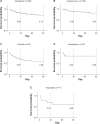Clinical characteristics and outcomes in 303 HIV-infected patients with invasive fungal infections: data from the Prospective Antifungal Therapy Alliance registry, a multicenter, observational study
- PMID: 24648769
- PMCID: PMC3958502
- DOI: 10.2147/HIV.S53910
Clinical characteristics and outcomes in 303 HIV-infected patients with invasive fungal infections: data from the Prospective Antifungal Therapy Alliance registry, a multicenter, observational study
Abstract
This analysis aimed to characterize the epidemiology, diagnosis, treatment, and outcomes of invasive fungal infections (IFIs) in patients with human immunodeficiency virus (HIV). Data were examined for HIV patients enrolled in the Prospective Antifungal Therapy (PATH) Alliance registry, a multicenter, observational study of patients with IFIs in North America from 2004 to 2008. Patient demographics, clinical characteristics, comorbidities, antifungal therapies, and survival were assessed. In total, 320 fungal isolates were identified from 303 HIV patients with IFIs in the PATH Alliance® registry. These included Cryptococcus (50.0%), Candida (33.1%), Histoplasma (9.1%), and Aspergillus (4.4%). Candida infection occurred mainly as candidemia (86.0%); Cryptococcus as central nervous system infection (76.7%); Histoplasma as disseminated infection (74.1%); and Aspergillus as pulmonary infection (81.8%). The CD4 cell count was ≤200 cells/μL in 91.2% of patients with available data. The majority of patients with Cryptococcus (77.9%), Histoplasma (100.0%), and Aspergillus (71.4%) infections had CD4 cell counts <50 cells/μL compared with 48.9% of patients with Candida infections. Patients with candidiasis were more likely to have other conditions requiring medical services compared with patients with other IFIs. Survival probability was lower in patients with Aspergillus (0.58) and Candida (0.59) infection than in patients with Histoplasma (0.84) and Cryptococcus (0.81) infection. In the highly active antiretroviral therapy era, traditional opportunistic IFIs such as cryptococcosis and histoplasmosis still mainly occur in HIV patients with CD4 counts <50 cells/μL. Fungal infections remain a clinical challenge in HIV patients with severe immunosuppression. Our data also suggest that HIV patients with CD4 cell counts >200 cells/μL and other underlying conditions may be susceptible to invasive candidiasis.
Keywords: Prospective Antifungal Therapy Alliance registry; human immunodeficiency virus; invasive fungal infections.
Figures
References
-
- Schneider E, Whitmore S, Glynn KM, Dominguez K, Mitsch A, McKenna MT. Revised surveillance case definitions for HIV infection among adults, adolescents, and children aged <18 months and for HIV infection and AIDS among children aged 18 months to <13 years – United States, 2008. MMWR Recomm Rep. 2008;57(RR-10):1–12. - PubMed
-
- Holding KJ, Dworkin MS, Wan PC, et al. Aspergillosis among people infected with human immunodeficiency virus: incidence and survival. Adult and Adolescent Spectrum of HIV Disease Project. Clin Infect Dis. 2000;31(5):1253–1257. - PubMed
-
- Mylonakis E, Barlam TF, Flanigan T, Rich JD. Pulmonary aspergillosis and invasive disease in AIDS: review of 342 cases. Chest. 1998;114(1):251–262. - PubMed
-
- Hogg RS, Heath KV, Yip B, et al. Improved survival among HIV-infected individuals following initiation of antiretroviral therapy. JAMA. 1998;279(6):450–454. - PubMed
-
- Palella FJ, Jr, Delaney KM, Moorman AC, et al. Declining morbidity and mortality among patients with advanced human immunodeficiency virus infection. HIV Outpatient Study Investigators. N Engl J Med. 1998;338(13):853–860. - PubMed
LinkOut - more resources
Full Text Sources
Other Literature Sources
Research Materials


